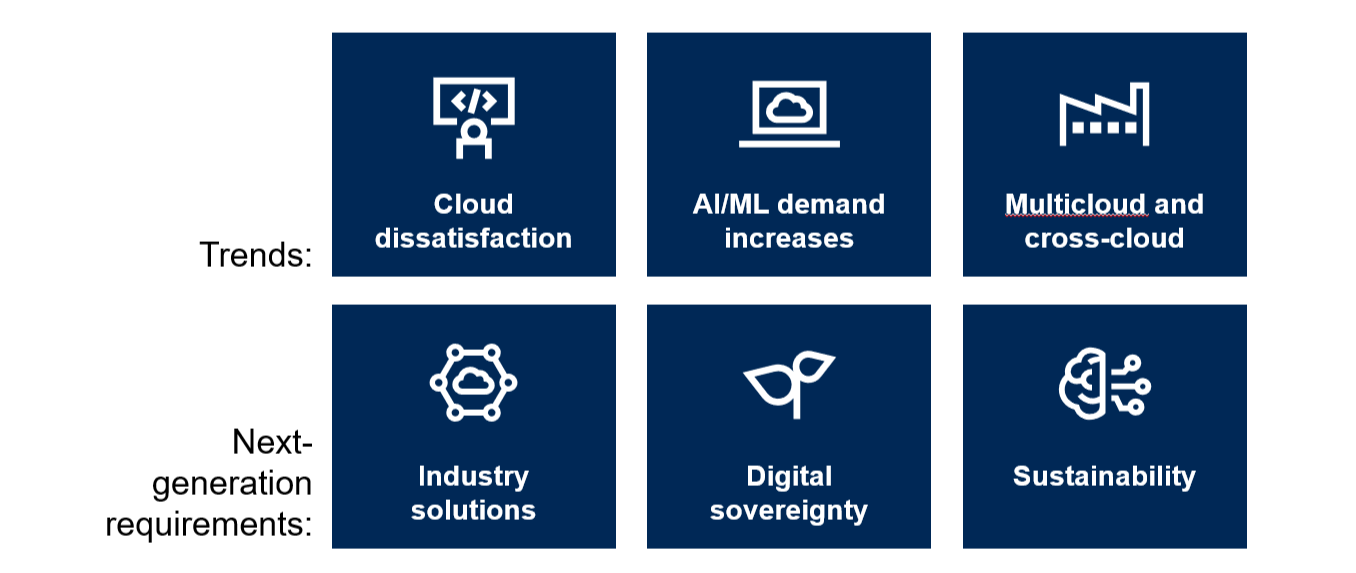Gartner Predicts 50% Of Cloud Compute Resources Will Be Devoted To AI Workloads By 2029
Dubai, United Arab Emirates, May 14, 2025 – Gartner, Inc. has announced the top trends shaping the future of cloud adoption over the next four years. These include cloud dissatisfaction, AI/machine learning (ML), multicloud, sustainability, digital sovereignty and industry solutions.
Joe Rogus, Director, Advisory at Gartner, said, “These trends are accelerating the shift in how cloud is transforming from a technology enabler to a business disruptor and necessity for most organizations. Over the next few years, cloud will continue to unlock new business models, competitive advantages and ways of achieving business missions.”
According to Gartner, the following six trends will shape the future of cloud, ultimately resulting in new ways of working that are digital in nature and transformative in impact (see Figure 1):
Figure 1: Trends Shaping the Future of Cloud

Source: Gartner (May 2025)
Trend 1: Cloud Dissatisfaction
Cloud adoption continues to grow, but not all implementations succeed. Gartner predicts 25% of organizations will have experienced significant dissatisfaction with their cloud adoption by 2028, due to unrealistic expectations, suboptimal implementation and/or uncontrolled costs.
To remain competitive, enterprises need a clear cloud strategy and effective execution. Gartner research indicates that those that have successfully addressed upfront strategic focus by 2029 will find their cloud dissatisfaction will decrease.
Trend 2: AI/ML Demand Increases
Demand for AI/ML is set to surge, with hyperscalers positioned at the core of this growth. They will drive a shift in how compute resources are allocated by embedding foundational capabilities into their IT infrastructure, facilitating partnerships with vendors and users, and leveraging real and synthetic data to train AI models. Gartner predicts 50% of cloud compute resources will be devoted to AI workloads by 2029, up from less than 10% today.
“This all points to a fivefold increase in AI-related cloud workloads by 2029,” said Rogus “Now is the time for organizations to assess whether their data centers and cloud strategies are ready to handle this surge in AI & ML demand. In many cases, they might need to bring AI to where the data is to support this growth.”
Trend 3: Multicloud and Cross Cloud
Many organizations that have adopted multicloud architecture find connecting to and between providers a challenge. This lack of interoperability between environments can slow cloud adoption, with Gartner predicting more than 50% of organizations will not get the expected results from their multicloud implementations by 2029.
Gartner recommends identifying specific use cases and planning for distributed apps and data in the organization that could benefit from a cross-cloud deployment model. This enables workloads to operate collaboratively across different cloud platforms, as well as different on-premises and colocation facilities.
Trend 4: Industry Solutions
There is an upward trend toward industry-specific cloud platforms, with more vendors offering solutions that address vertical business outcomes and help scale digital initiatives. Over 50% of organizations will use industry cloud platforms to accelerate their business initiatives by 2029, according to Gartner.
Gartner recommends organizations approach industry cloud platforms as a strategic way to add new capabilities to their broader IT portfolio, rather than a total replacement. This allows organizations to avoid technical debt, drive innovation and business value.
Trend 5: Digital Sovereignty
AI adoption, tightening privacy regulations and geopolitical tensions are driving demand for sovereign cloud services. Organizations will be increasingly required to protect data, infrastructure and critical workloads from control by external jurisdictions and foreign government access. Gartner predicts over 50% of multinational organizations will have digital sovereign strategies by 2029, up from less than 10% today.
“As organizations proactively align their cloud strategies to address digital sovereignty requirements, there are already a wide range of offerings that will support them,” said Rogus. “However, it’s important they understand exactly what their requirements are, so they can select the right mix of solutions to safeguard their data and operational integrity.”
Trend 6: Sustainability
Cloud providers and users are increasingly sharing responsibility for sustainable IT infrastructure. This is being driven by regulators, investors and public demand for greater alignment between technology investments and environmental goals. As AI workloads demand more energy, organizations are also under pressure to better understand, measure and manage the sustainability implications of emerging cloud technologies.
Gartner research shows the percentage of global organizations prioritizing sustainability as part of procurement will rise to over 50% by 2029. To deliver greater value from cloud investments, organizations must look beyond environmental impact alone and align their sustainability strategies with key business outcomes.
Gartner clients can read more in The Future of Cloud in 2029: The Journey From Technology to Business Necessity and Predicts 2025: Challenges Shaping the Future of Cloud Adoption.
Learn how to maximize the benefits of cloud computing in the complimentary Gartner ebook Devising an Effective Cloud Strategy.
